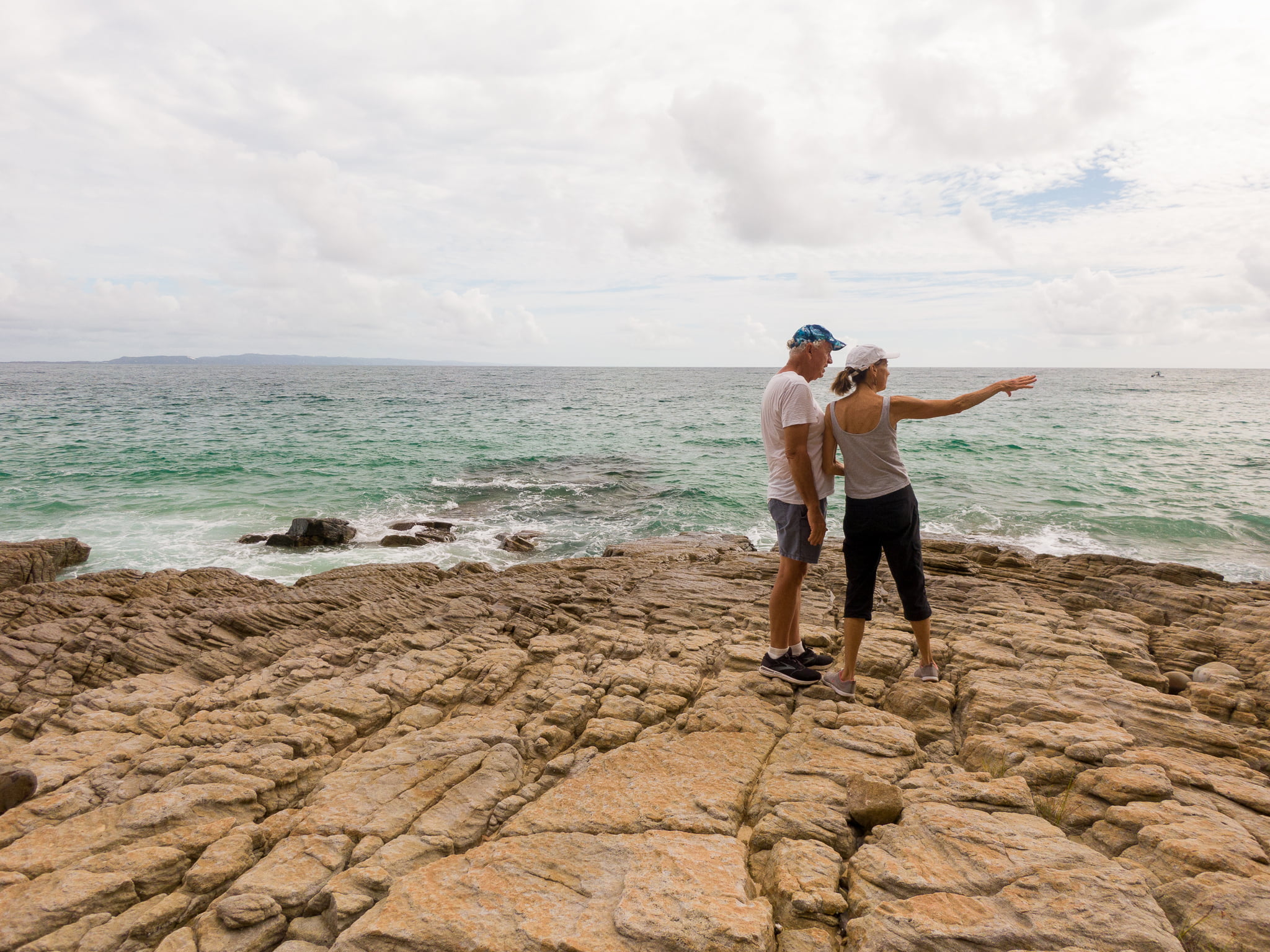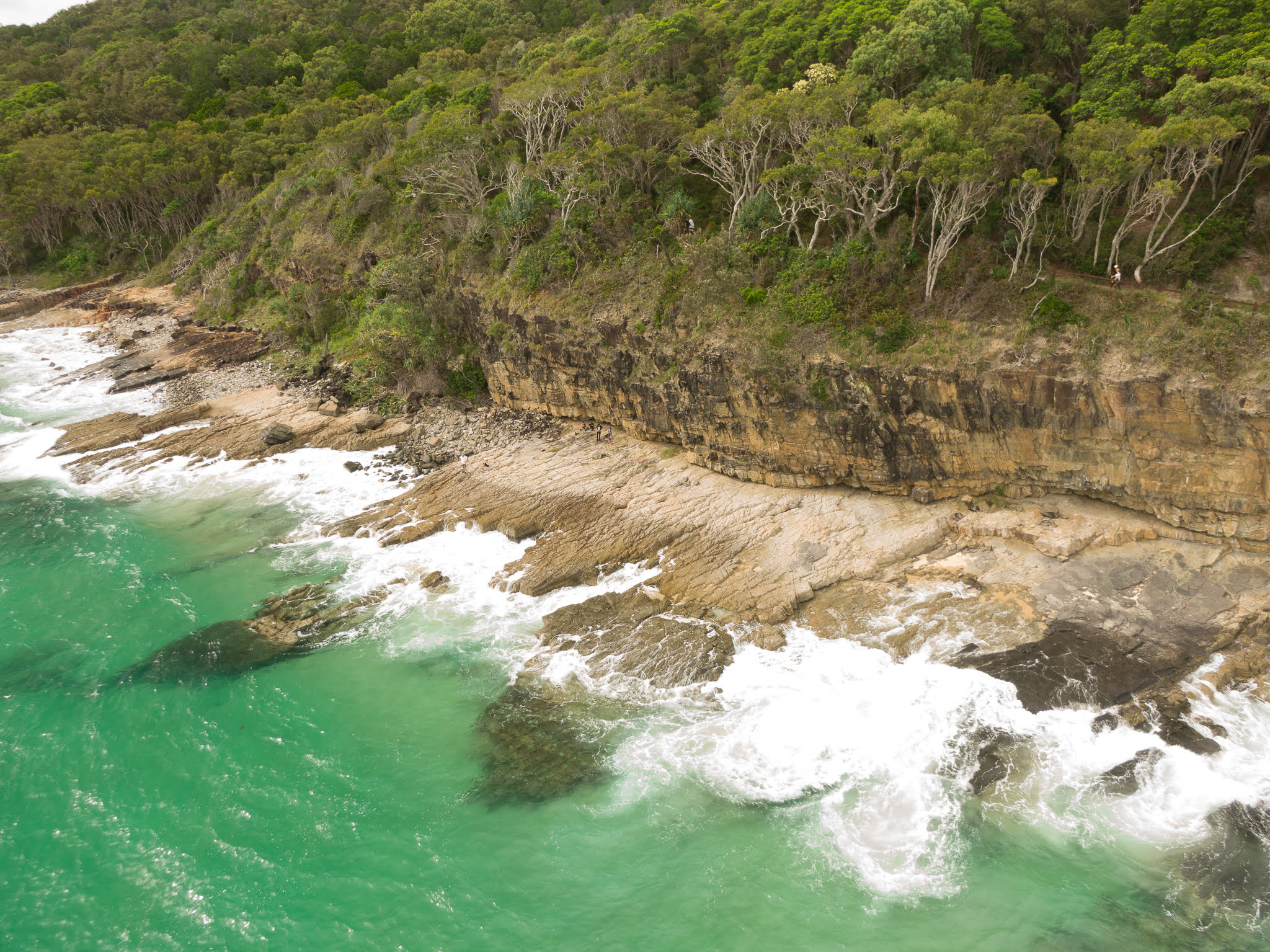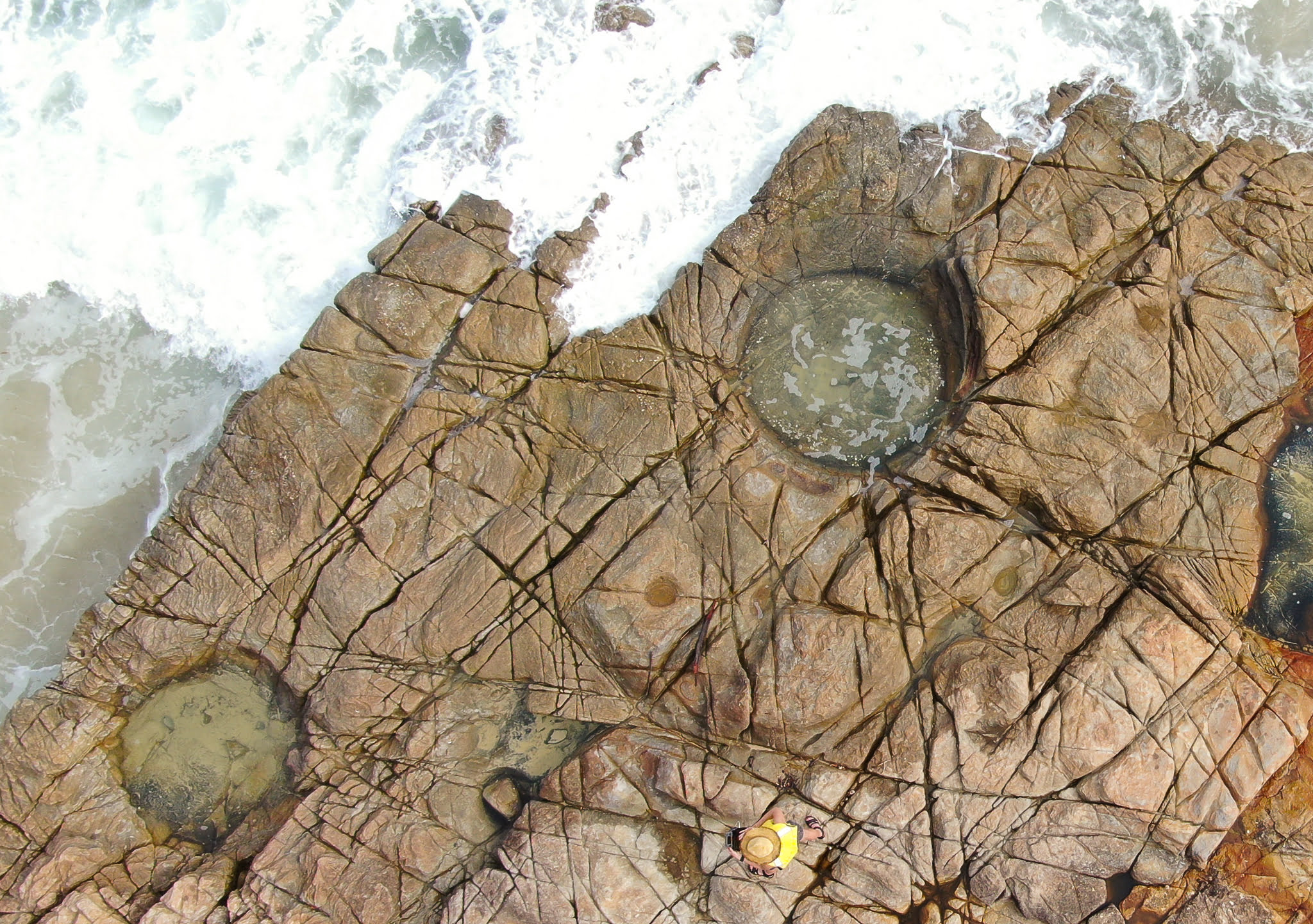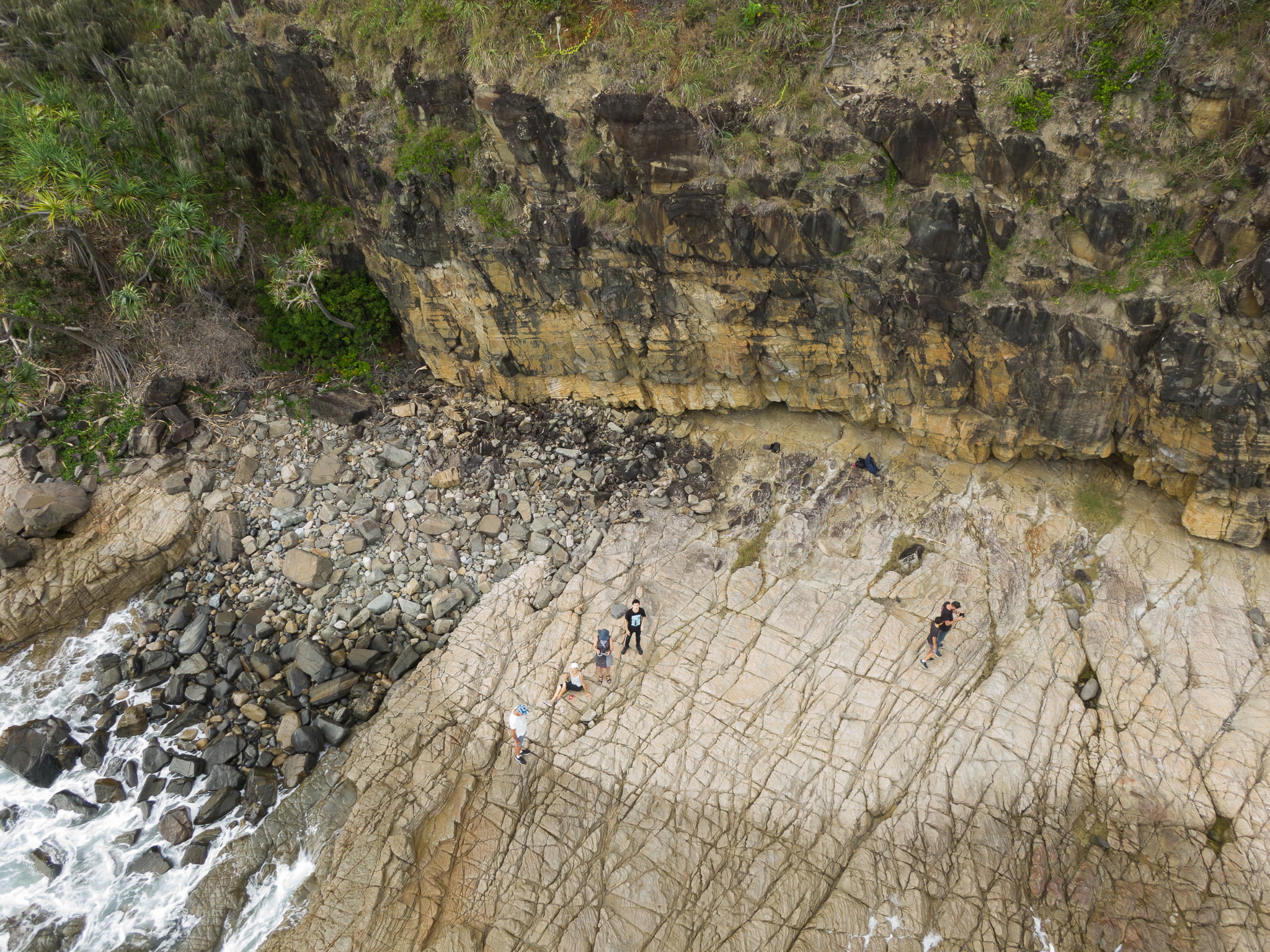I have been waiting for catastrophic sea level rise to wash me from the rock platform a few headlands around from where I live at Sunshine Beach in Noosa Shire about halfway along the east coast of Australia that is on the edge of the western South Pacific Ocean.
I like to stand on that platform of sandstone, sandstone that perhaps dates to the Jurassic – the time of the dinosaurs – and thumb my nose at all the catastrophe on the nightly news about global warming and rising sea levels.
The highest tide this year is forecast for 8.27 am on Monday 3rd January (2022) at 2.29 metres.
It just might happen this year, that I get washed away. If there is a low-pressure system offshore and big winds, as forecast.
We were there on that platform for the very highest tide last year, but the waves never made it even to our ankles. So, much for catastrophic sea level rise, I thought.

The cliff face behind reaches up perhaps 30 metres to the famous Boiling Pot Lookout.
There is a wave cut notch running right around the base of the cliff face – where the rock platform begins.
The cliff face has been formed by undercutting: from waves swirling beneath until they bring down great lumps of rock, to be removed by the wash.
And so, the headland has receded landward, and the platform become wider. But it’s not happening anymore, because sea levels are not as high as they used to be.
Logically, sea levels must have once been much higher because now even on the highest tide for the year the waves don’t reach the bottom of the cliff face, the notch. On highest tides long ago, the waves must have smashed against the cliff face.

According to the most recent Intergovernmental Panel on Climate Change report (AR6) – temperatures are the warmest they have been for at least the last 125 000 years.
Has it really been that long since the ocean lapped at the base of this cliff below the Boiling Pot Lookout? Is my favourite rock platform that old – 125 000 years old? Has it been just so wide for that long?
There are marine potholes in the sandstone just two rock platform to the southeast, towards Tea Tree Bay. The fracture around one of the rings suggests a pre-existing body, possibly a fossilised tree trunk. A geologist emailed me two years ago: note the pattern of dimples around the pothole which, if it is a Jurassic age sediment could be due to the presence of roots of Taxodium; I’ve posted a picture of that swamp cypress at an earlier blog post, click here.

Various texts on the geology of this area suggest that the sandstone was indeed laid down about 180 000 000 years ago. Back then the east coast of Australia faced south and this region was far inland and an intact sedimentary basin – far from the waves and the sea tides.
That was a long time ago, 180 million years ago.
When did the ocean first reach the sandstone and begin eroding it, forming the cliff face below Boiling Pot Lookout?
This is just one of the questions that I will ponder as I face the ocean next Monday from my favourite wave-cut platform below the lookout, weather permitting.
**********
Standing on rocks is what rock fishers do, and it is considered one of the most dangerous sports in Australia with 158 deaths in the 13 years to 2017. To reduce the risk of injury it is advisable to:
- Wear a lifejacket
- Check tides weather and surf conditions
- Take personal responsibility, think twice and assess my safety
- Plan an escape route in case I am washed into the water
- Wear the right gear i.e. lifejacket, appropriate footwear, lightweight clothing
- Never fish/go alone, and make sure you tell someone where you are going and when you will be back
- Look for Angel Rings or someone other floatation device to throw to someone in trouble
- Call 000 if assistance is required.
There is more information at my sea level change page, click here. If you like sharing, the short link to this blogpost is https://wp.me/p3uL4U-4Yf
**** UPDATE 31st December 2021



 Jennifer Marohasy BSc PhD is a critical thinker with expertise in the scientific method.
Jennifer Marohasy BSc PhD is a critical thinker with expertise in the scientific method.

H.H. Lamb, “Climate History and the Modern World”, 2nd edition, page 115 of the paperback:
“….but there is considerable agreement that the most rapid phases [of sea level rise] were between about 8000 and 5000 BC, also that the rise of general water level was effectively over by about 2000 BC, when it may have stood a metre or two higher than today.”
I never tire of your articles and posts Jennifer. Always refreshing, honest and informative. Have a great New Year.
Great post Jen,
Looking forward to seeing more in 2022
Thanks Jen. What a shame these climate experts don’t put their heads outside to actually see what is going on. Those old 9 foot king tides [2.743 m] we got in Moreton Bay when I was a kid are still predicted by the BoM [Sat 3/1/22 predicted at 2.73 m] and my experience over the last decade or so is that they are up to 250 mm LOWER than their levels between 1946 and 1953 when corrected for barometric pressure.
My old benchmarks are based on still existing sea walls and jetties I built to that datum and I have yet to see modern tides reach those levels except when there is cyclonic influence involved.
That is some nice work there, Jen.
If that is sandstone on the platform with the two big roundish holes, there is a whole other story as well. Sudden, massive inundation of a couple of serious trees by water and “sand”, possibly rapidly followed by even deeper burial and possibly lava floods on top of that. Any sign of Basalt on the higher bits of the less-eroded headland? Quite a few serious volcanoes once occupied a lot of South East Queensland.
As the Australian Plate has trundled slowly north-west for millions of years, I’d say it might have disrupted a LOT of seabed. Thus the occasional serious Tsunami. There is an interesting bit of reasonably old folklore from the Burdekin River folks, about having to literally run for the very few available hills to escape “BIG waves” a few centuries pre-Cook, and all that. There are beaches in northern New South Wales that have enormous, rounded boulders tossed up into the back dunes. Pretty much the entire NSW Norther Rivers District is in the floor of an extinct “supervolcano”. The thousand-foot high cliff that forms the southern boundary of Lamington Plateau, appears to be a remnant of the north wall of this caldera. The oceans may well (and actually do) change peak height, but the LAND moves in THREE dimensions and has done forever.
At long last official confirmation that the IPCC has been making corrections and adjustments to global temperature records (a euphemism for fiddling temperature data) after years of denial and the climate-gate emails scandal. This confirmation addressed to me via an official letter from the UK Minister of State for Energy, Clean Growth and Climate Change, in the Department for Business, Energy & Industrial Strategy which is headed by Alok Sharma who was also President of the COP26 conference. This letter is dynamite and brings into question the current political narrative and theory of the causes of climate change. More to follow. Your comments please Jennifer.
Again, great photos, Jennifer.
The problem I have with the “tree trunk” hypothesis for the formation of those potholes is that the joint fractures are not displaced across the pothole, merely eroded (scoured) out along their strike. If they had formed with a fossilised tree trunk in the way, displacement along strike at the intersection would occur as the strain energy refracts through a change of medium obstacle. (The joint sets develop when the sand is almost lithified, brittle). I expect the emailing geo (whom I know to be PL) will be along to disagree – that’s healthy.
From Google Earth, the cliff to sea strike for that fracture set on the wave platform is N-S with a conjugate E-W set, so the prominent cross-fracture set is NNW with some lateral displacement along the pre-existing N-S set. The NNW set is ubiquitous within the underlying Triassic sandstones along the Aus east coast.
Jennifer, if I’ve misidentified the strike of the fracture sets through Google Earth, please supply the orientation from your drone ?
Happy New Year wishes to Jnnifer with much appreciation from the USA.